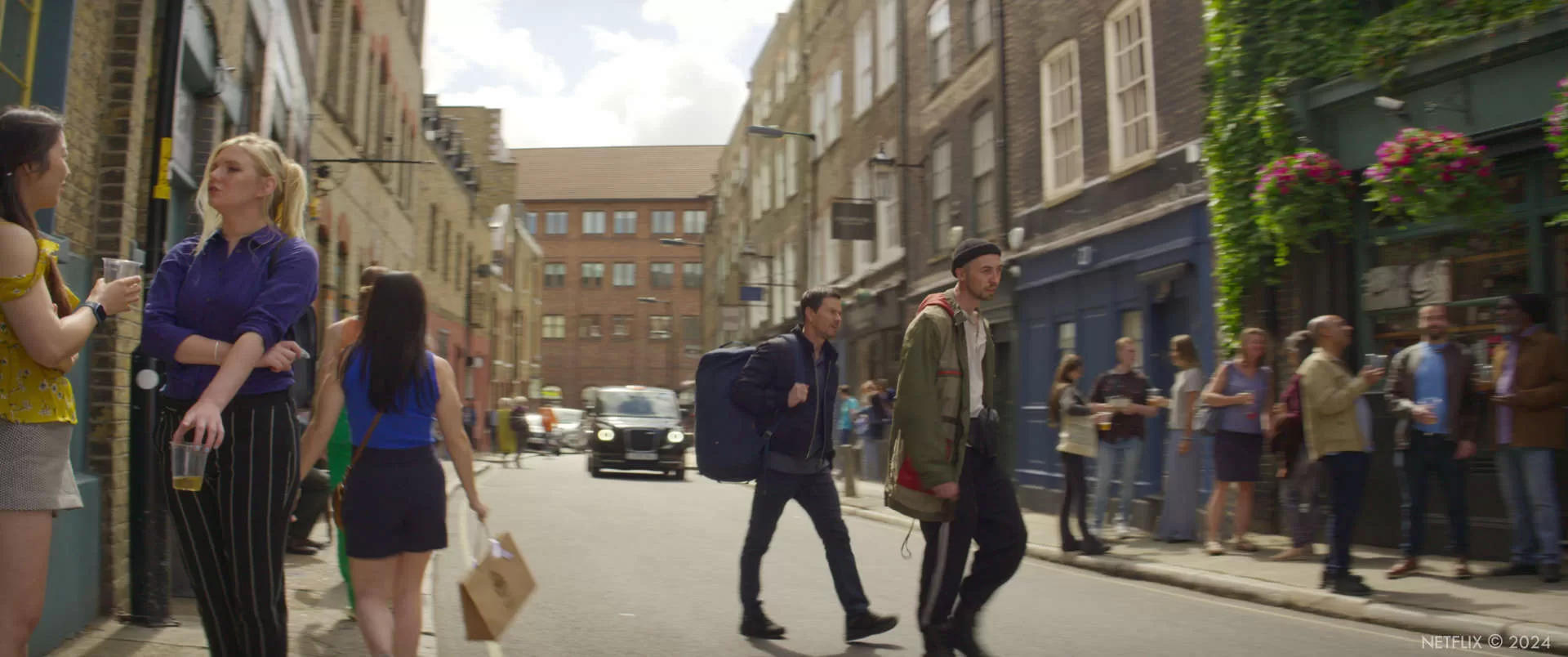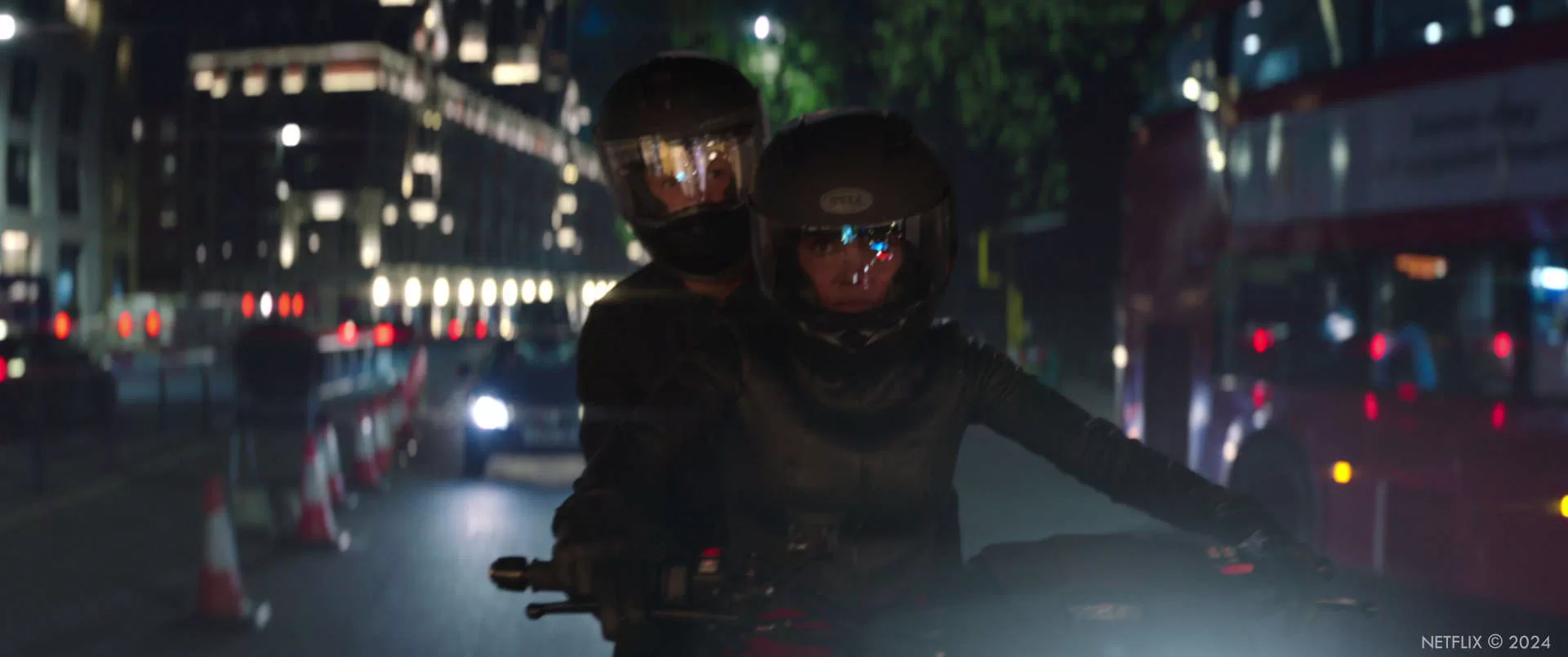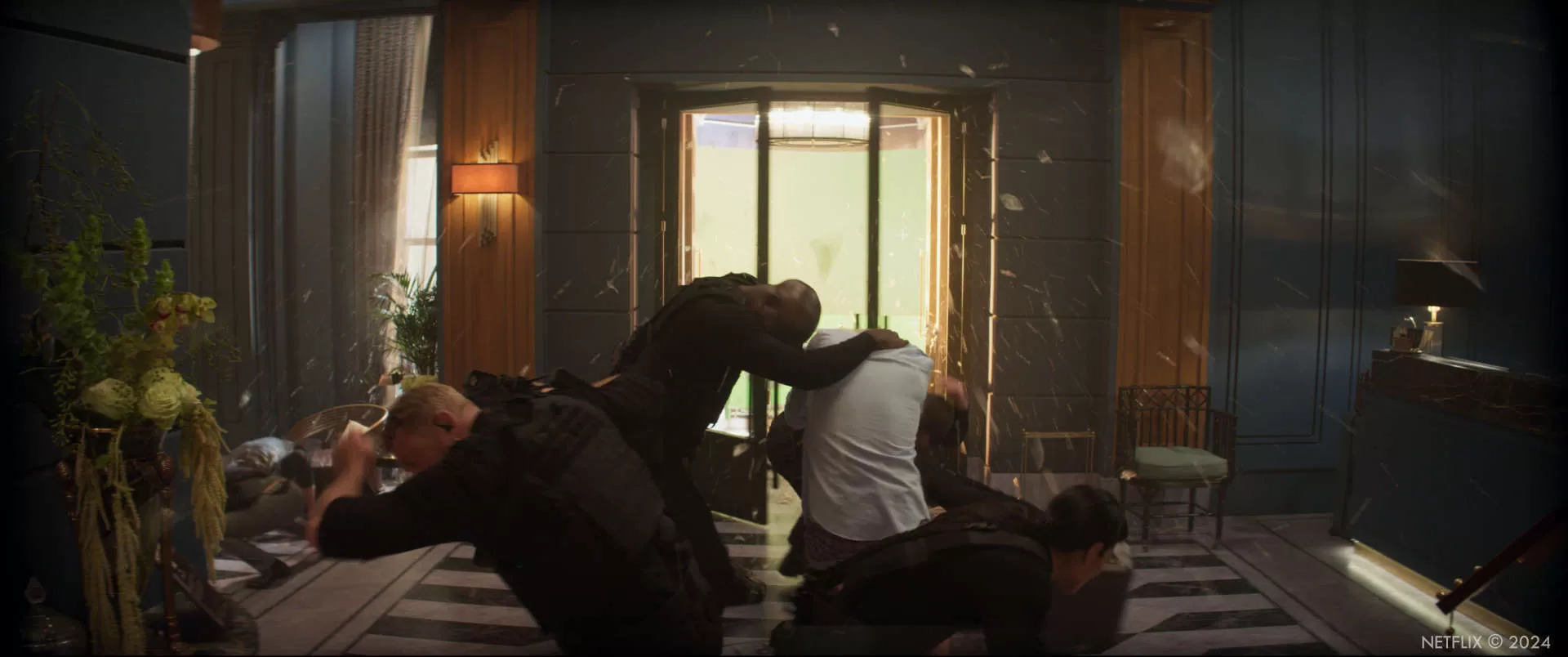Back in 2020, Adam Rowland shed light on the VFX behind An American Pickle. Since then, his expertise has shaped the visual effects in shows like The Irregulars, Landscapers, The Unbearable Weight of Massive Talent, Masters of the Air, and Borderlands.
Wendy Garfinkle‘s career in visual effects spans over two decades, contributing her expertise to films and series like Zoolander 2, The Alienist, Project Power, and The Northman.
How did you get involved on this movie?
Wendy Garfinkle (WG): October 2021… my agent, Harriet Donington, set-up a call with producers, Jeff Waxman and Jennifer Madeloff. Maybe it was the fact that I previously lived in New York for 15 years and they’re from New York and New Jersey respectively, but there was an immediate ease in speaking with them.
Adam Rowland (AR): I was on location, shooting Masters of the Air, when I received a call from Julian, the director. I ducked into a make-up tent and we chatted about the script (which was quite different then), and I guess I passed the test. A few days later, Wendy and I spoke. I was on my long drive back from Bovingdon airfield and we chatted for over an hour about lots of things, not all work-related. I knew from that initial conversation that we would be a great team.
How was the collaboration with Director Julian Farino?
AR: Overall, excellent. Julian wasn’t hugely experienced with VFX when we started, so was initially a little perplexed by our conversations during prep and some of our methods during the shoot, but he trusted us to guide him. He also came to understand that we would be among the few people from the shoot remaining by his side through post. It was then, in post, when we were based a few doors down from the edit, that we were able to build a more intimate rapport. There evolved an open-door policy and he would often ask our advice on matters of the film unrelated to VFX, which was very special as it is not always the case.
WG: Basically, what Adam said. While shooting, Julian would often say to me, “We’re going to be spending a lot of time together, aren’t we?”, to which I’d reply, “YES, we are!”. He’s an extremely gracious person and an absolute joy to work with.
How did you choose the various vendors and split the work amongst them?
WG: The plan was always to have one main vendor taking on the bulk of the work with support from an in-house team. Based on the scope of the VFX, Cinesite London was selected our lead vendor. We started off with two in-house compositors working remotely, Matt Wilmshurst and Marios Theodosi. As the workload increased, we eventually enlisted Lev Kolobov and his team of merry makers at RED VFX. Lola VFX were brought on later for some specialty beard work on our additional photography which was shot in 2023, a year after our initial wrap in 2022.


What were the main challenges in creating the visual effects for this film, particularly in recreating London environments?
WG: Having never shot in Central London, it’s a little tricky! Logistically, things are tight. I’m more used to the wide avenues of Manhattan. There were some location restrictions which resulted in more VFX. Not totally uncommon, but I was a bit surprised by some of the limitations we came up against.
AR: As Wendy said, Central London is not an easy place to film. We were also shooting in the run up to the Queen’s Platinum Jubilee, so the city was very busy. Various locations either fell through or would only allow limited access, so production had to be quite nimble to adapt to last-minute changes. Sets were built in order to perform stunt work safely in the studio and the location work, specifically in Covent Garden, was stripped to a bare minimum or shifted elsewhere. For example, the gunfight sequence outside the pub was actually shot in Southwalk, and the buildings and streets were augmented and extended digitally to look more like the area round Seven dials.


How did you ensure that the digital recreations of London were accurate and realistic?
WG: In addition to our on-set data wranglers shooting loads of reference, we had skilled technicians from Clear Angle Studios who scanned all the environments and sets we needed so that we could make up for the days we were restricted to shooting on location.
AR: It was important that the buildings were architecturally appropriate for the area, that any augmentations were visually appropriate, appearing contiguous to existing buildings, and that everything looked photoreal. We scanned and photographed as much as possible, taking lighting and texture reference of everything. We had limited time on all locations in Central London, so we often had multiple teams in different areas collecting data while we had control of the streets and rooftops.
Can you walk us through the process of integrating real-world footage with CGI for the London scenes?
AR: We used a combination of techniques from 2D DMPs to full CG builds, but I’ve always tried to put the emphasis on: reference the plate. The gunfight sequence outside the pub was shot over several days and contains 4 different set extensions in 4 different directions, so the lighting is quite inconsistent shot-to-shot. What this meant was that a DMP that might work for one shot may not fit into another shot of the same angle, as it could have been shot at different time of day under different conditions. It was more important to me that the VFX bedded well into the plates than was simply the same in each shot, as the viewer’s eye will forgive inaccurate continuity over incorrect lighting. This meant that Cinesite often had to create multiple versions of the same extension to match the changing conditions.


How did you collaborate with the production design team to ensure consistency between practical sets and digital environments?
AR: We worked closely with the production designer Morgan Kennedy, ensuring we were able to complete his vision where VFX had to take over for whatever reason. Scenes like the one with Roxanne travelling from the roof down the side of the Seven Dials Radisson Blu, and in Ching Court where Mike fights the female assassin, were a combination of location photography and set-builds where the stunts could be filmed. The sets were all designed using the existing locations as reference, with quite extraordinary attention to detail, so there was already a very close semblance between the two. You can go to the actual Ching Court and see the actual skylight that Mike and the assassin fall through, which was recreated on a stage in Shepparton. The accuracy is uncanny!


Were there any historical landmarks in London that posed a particular challenge when it came to recreating them digitally?
AR: The rooftop of the Tower Hotel overlooking Tower Bridge, was quite small and difficult to access, so there was often a lot of crew, rigging and kit visible in shot. It was clear it would require at the least a lot of cleanup and at the most a total rebuild. As we intended to augment the architecture to have the walkway of the rooftop look more precipitous, we leant more heavily into redesigning the building – removing entire sections and adding slopes and other features while maintaining the brutalist architecture.


How did you handle crowd simulations in the London scenes?
AR: There are no actual crowd simulations in the film, as far as I recall. We were able to shoot elements for most of what we needed, either against bluescreen in between takes, or from rooftop and drone on location.
What role did digital doubles play in the visual effects, especially during high-intensity sequences?
AR: Surprisingly little. All of the stunts are in-camera, aside from the shot of Mike as the car drives over the cliff, which is a Cinesite digidouble. We couldn’t convince the stunt team to do that one for real!
WG: We scanned specific actors, as you do just in case, but thankfully we didn’t end up needing to use them. We truly had a ace stunt team.


How much of the final sequence was shot on location versus created digitally?
AR: Shot in Piran, Slovenia, the rooftop sequence and descent into the alleyway was largely location photography with the choreographed stunts shot safely on set-builds against bluescreens. However, all of the car chase sequence was shot for real on location in Croatia.
Were there any elements of the final sequence that were particularly difficult to execute from a visual effects standpoint?
AR: There’s a section of the Piran rooftop sequence that proved quite tricky. The whole scene was shot over several days and contains 360 views across the rooftops. Sometimes they’re real locations sometimes they’re set-builds with CG or DMP extensions. The build for the moment when the Iranians and Mike confront one another on the beams was quite basic; just the two beams against bluescreen – and the day we shot it was more overcast than the day on location. We had particular difficulty marrying the flatter foregrounds with the more directly lit plates while maintaining continuity across the sequence.
How did visual effects contribute to enhancing the stunts in the movie?
AR: We were on hand to remove visible wires and rigging of course, but by and large the stunts are in-camera. Adam Kirley, the Stunt Coordinator, did a great job and his team were awesome. Mark and Halle were quite keen to do as much as possible, within reason, and when the stunt people performed instead we were prepared for the occasional face-replacement. Because the rooftop sequence in Piran was shot both at the location and on partial set-builds, we had good reference for the actors in the actual environments for when face replacements would be needed. We were also able to scan and photograph the alleyway and rooftop locations extensively, in the correct lighting conditions, in order to replicate them for the CG extensions.


Can you give examples of stunts that were made possible or more dramatic through the use of VFX?
WG: There were so many awesome practical stunts. A lot of the time all we had to do was remove some rigs and replace faces. There was one stunt in particular where an assasin’s neck is broken. A dummy was rigged and we replaced the face. Based on the reaction from the audience, it’s clear that combination worked.
AR: Agreed. The practical stuntwork was so great we generally didn’t have to get too involved. Even the jump from Albert Bridge was done for real with no wires – we just had to remove some safety mats and add Mark and Halle’s faces.
Were there any unexpected technical or creative challenges encountered during the production?
WG: The location restrictions here in London as well as Piran, Slovenia… that was a bit of a surprise. Thankfully we were able to pivot in time to accommodate the additional VFX.
AR: We shot a lot of the London driving shots against LED at the Arri stage in Uxbridge, with the intention to get as many of them in-camera as possible. However, the turnaround time to get the array footage shot, selected, stitched, supplied and ingested was very tight. The shooting days were also tight and it wasn’t always easy to nudge the footage into the correct perspective on the LED screen, so for a lot of them we had the Arri technicians drop a digital greenscreen behind the actors only so we could refine the backgrounds later. This helped a lot when it came to the edit, as obviously the cut changed, and we were able to have the backgrounds appear as a continuous, seamless journey. This technique also allowed us to maintain all the in-camera lighting and reflective interactions from the LED footage – even if it wasn’t 100% accurate to what the background was going to be. This worked well for both the car and the motorbike, where they are wearing leather and shiny helmets. Having the footage reflecting off all the creases of their jackets and the chrome of the bike helped the believability of these comps enormously.


Were there any memorable moments or scenes from the film that you found particularly rewarding or challenging to work on from a visual effects standpoint?
WG: I started off in commercials and worked on my fair share of car accounts. So I quite enjoyed the end car chase scene. There was a crazy amount of detail that had to be done for continuity in addition to removing the stunt pods from the roofs. Cinesite really did an amazing job.
AR: An additional photography shoot was scheduled nearly a year after the rest of the film had wrapped, by which time JK Simmons had shaved his beard. What you see in a few scenes, including the shots of him at the wedding reception, is a combination of a prosthetic bead and digital groom. This was not work that we had anticipated would be required, but it was clear in the edit the prosthetic didn’t match closely enough to his real beard. Lola VFX did a great job, all the more impressive considering they were provided with nothing but references of the original beard – no cyberscan, tracking data, HDRIs, nothing.


Looking back on the project, what aspects of the visual effects are you most proud of?
AR: I think the car chase sequence towards the end works really well, and it’s one that a lot of people seem to like. I remember seeing some of the footage coming out of 2nd unit while we were shooting main unit in a different part of Istria and thinking “Holy shit”! It wasn’t initially supposed to be a VFX-heavy sequence, being mostly designed as practical stunts, but a combination of Roxanne’s reflective sunglasses and the driving pods on top of the vehicles turned it into one of our biggest. José Armegol, who was our 2nd unit supervisor, dealt brilliantly with the unpredictability of that shoot and got everything we needed – and Max Dennison’s team at Cinesite did a great job removing pods and their reflections, fixing backgrounds, mirrors and windscreens, and adding a few face replacements where required. Special shout out too to Marios Theodosi at ArtfulFX, who almost singlehandedly fixed all the camera/rig/road reflections in Roxanne’s shades.
WG: I concur with Adam!
How long have you worked on this show?
WG: I had a soft start November 2021 and wrapped mid October 2023. We were supposed to have a shoot hiatus summer of 2022, but as we had vendors working, we were never really “pencils down”. It was a long slog, but our VFX team was truly awesome. We had a lot of laughs.


What’s the VFX shots count?
Around 960.
What is your next project?
WG: I’m anxiously awaiting my next exciting adventure!
AR: I am about to start prepping another Mark Wahlberg movie.
A big thanks for your time.
The Union: Cinesite – VFX Breakdown
WANT TO KNOW MORE?
Cinesite: Dedicated page about The Union on Cinesite website.
© Vincent Frei – The Art of VFX – 2024




